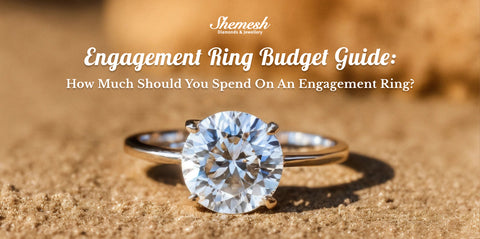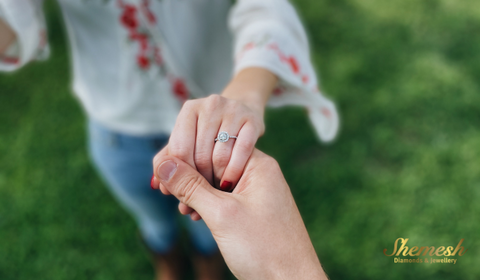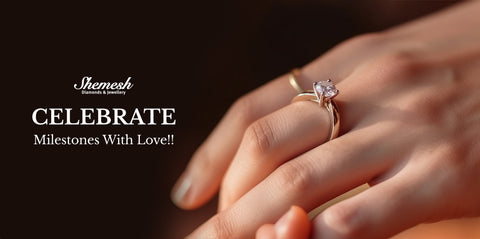
Engagement Ring Budget Guide: How much Should you Spend on an Engagement Ring?
Choosing an engagement ring is an exciting and significant decision in any relationship. It symbolizes love, commitment, and the beginning of a new chapter. However, one question that often arises during this process is: How much should you spend on an engagement ring?
Determining a budget for an engagement ring involves careful consideration of various factors. This guide will explore these factors and provide valuable insights to help you make an informed decision about your engagement ring budget.
So, let us embark on this journey together and discover the best way to navigate the engagement ring budgets.
Factors to Consider When Setting an Engagement Ring Budget

Let's take a closer look at the key factors to consider when setting an engagement ring budget.
-
Financial Situation - Your current financial situation is an important starting point when determining how much you can comfortably spend on an engagement ring. Take a realistic look at your income, expenses, and savings to determine what you can afford. Consider your monthly budget and any existing financial commitments, such as student loans or credit card debt. It's crucial to set a budget that won't strain your finances and cause unnecessary stress.
-
Personal Preferences - Everyone has different tastes and preferences when it comes to engagement rings. Some may prefer a simple and elegant design, while others may desire a more elaborate and intricate ring. Think about your partner's style and preferences, as well as your own, when deciding on the type of ring you want to purchase. This will help you narrow down your options and allocate your budget accordingly.
-
Quality of the Stone - The stone's quality is an essential factor to consider when setting your engagement ring budget. Diamonds are graded based on the four C's: carat weight, cut, color, and clarity. These factors significantly impact the overall cost of the diamond. If a larger stone is a priority for you, you may need to compromise on other aspects, such as the color or clarity. Understanding the importance of these factors will help you make an informed decision within your budget.
-
Ring Setting and Design - The setting and design of the ring also play a role in determining its cost. Intricate settings, such as pave or halo designs, often come with a higher price tag due to the additional craftsmanship involved. The metal choice, whether platinum, gold, or silver, can also affect the cost. Consider the style and design elements that are important to you and factor in the cost accordingly.
-
Lifestyle and Activities - Your lifestyle and daily activities should be taken into consideration when setting an engagement ring budget. If you or your partner have an active lifestyle or work in a profession that requires frequent use of your hands, you may want to opt for a ring with a lower profile or a more durable setting. This will ensure that the ring can withstand everyday wear and tear without the need for frequent repairs or replacements.
- Long-Term Financial - Goals Setting an engagement ring budget shouldn't be viewed in isolation; it should be considered in the context of your long-term financial goals. Are you planning to buy a house, start a family, or save for retirement? Understanding your broader financial goals will help you determine how much you can comfortably allocate towards an engagement ring without sacrificing your future financial security.
Understanding the 3-Month Salary Rule

When it comes to setting an engagement ring budget, one commonly referenced guideline is the 3-month salary rule. This rule suggests that an individual should spend three months' worth of their salary on an engagement ring. However, before blindly adhering to this guideline, it's important to understand its origins, criticisms, and alternatives.
Origins of the 3-Month Salary Rule
The 3-month salary rule gained popularity in the mid-20th century through a marketing campaign by the diamond industry. De Beers, a major diamond company, wanted to encourage consumers to spend more on engagement rings. By promoting the idea that an engagement ring should be a significant financial investment, they aimed to increase diamond sales.
Criticisms of the 3-Month Salary Rule
Despite its widespread acceptance, the 3-month salary rule has faced criticism from various perspectives. One of the main criticisms is that it puts unnecessary pressure on couples to spend a large sum of money on a ring. It can create financial strain and lead to debt, especially for individuals who may already have other financial commitments.
Moreover, the rule assumes that everyone's financial situation is the same, which is far from reality. Factors such as income, expenses, and personal financial goals differ for each individual. Therefore, the 3-month salary rule fails to account for these variations and may not be a practical guideline for everyone.
Alternatives to the 3-Month Salary Rule
While the 3-month salary rule may not be suitable for everyone, there are alternative approaches to setting an engagement ring budget. One option is to focus on what you can comfortably afford rather than adhering to a specific percentage of your salary. Consider your financial obligations, savings goals, and long-term plans when deciding on a budget.
Another alternative is to prioritize the quality and significance of the ring rather than its price tag. Instead of focusing solely on the size of the diamond, consider factors such as its cut, clarity, color, and overall design. A smaller diamond of higher quality can often be more visually appealing and meaningful than a larger, lower-quality stone.
It's also worth discussing your budget openly with your partner. Communication is key in any relationship, and this includes being transparent about financial matters. By having an open and honest conversation about expectations and priorities, you can work together to find a budget that aligns with both of your desires.
Tips for Setting a Realistic Engagement Ring Budget

When it comes to setting a budget for an engagement ring, it's important to strike a balance between your financial situation and your desire to find the perfect symbol of your love. Here are some tips to help you set a realistic engagement ring budget:
Research Average Engagement Ring Costs
Before you start shopping for an engagement ring, it's crucial to have a general understanding of the average costs. Take some time to research the average price range for engagement rings with similar specifications to what you have in mind. This will give you a baseline to work with and help you avoid overspending or getting swindled by inflated prices.
Consider the Quality of the Diamond
The quality of the diamond you choose will greatly impact the price of the engagement ring. Diamonds are graded based on the "Four Cs": cut, color, clarity, and carat weight. Knowing how these factors affect the overall appearance and value of a diamond can help you make informed decisions. Keep in mind that you don't necessarily have to prioritize all the Cs equally. Depending on your partner's preferences, you can choose a diamond with a higher cut or clarity grade while being more flexible with color or carat weight. This approach allows you to allocate your budget more efficiently.
Seek Professional Guidance
Engagement ring shopping can be overwhelming, especially if you're not well-versed in the world of diamonds and jewelry. Seeking professional guidance from reputable jewelers can be immensely helpful. They can educate you on diamond quality, pricing, and different options available within your budget. A knowledgeable jeweler can also assist in finding a ring that matches your partner's style and preferences while staying within your financial limitations.
Debunking Engagement Ring Budget Myths

In this section, we will debunk these myths and provide you with a clearer perspective on how to approach your engagement ring budget.
Myth 1: Expensive Means Better Quality: Contrary to popular belief, the price tag on an engagement ring is not always indicative of its quality. While high-end brands may command higher prices, it does not necessarily mean their diamonds are superior. The key to finding a quality ring lies in understanding the four Cs: cut, color, clarity, and carat weight. Educate yourself on these factors to make an informed decision, rather than relying solely on price as a measure of quality.
Myth 2: You Can't Find Luxury Within Your Budget: Luxury doesn't always equate to exorbitant prices. With careful research and consideration, you can find a stunning engagement ring that fits your budget. Explore reputable online jewelers, compare prices, and take advantage of seasonal sales or promotions. By doing so, you can discover hidden gems that offer both exceptional quality and affordability.
Myth 3: Size Matters Above All Else: While a large diamond may seem enticing, it's important to remember that size isn't everything. The beauty of an engagement ring lies in its overall design and craftsmanship. A smaller diamond with excellent cut and clarity can often outshine a larger stone with inferior qualities. Prioritize the overall aesthetic appeal and the emotions it evokes, rather than solely focusing on carat weight.
Myth 4: You Must Purchase a Diamond Ring: Diamonds have long been associated with engagement rings, but they are by no means the only option. Consider alternative gemstones such as sapphires, emeralds, or even lab-grown diamonds. These stones offer unique beauty, and durability, and may be more budget-friendly. By exploring different options, you can find a ring that perfectly suits your partner's personality and style.
Myth 5: You Shouldn't Seek Expert Advice: Navigating the world of engagement rings can be overwhelming, especially for naive online shoppers. Seeking expert advice from jewelers or industry professionals can help you make an informed decision. They can guide you through the various options, explain the technical aspects, and provide valuable insights. Take advantage of their expertise to find the perfect ring that meets both your budget and your partner's desires.
Remember, setting a realistic engagement ring budget doesn't mean sacrificing the sentiment behind the ring. The most important aspect of an engagement ring is the love and commitment it represents. By understanding the factors that influence the price of an engagement ring and seeking expert advice, you can find a ring that not only fits within your budget but also captures the essence of your relationship.
Things to Think About When Purchasing an Engagement Ring

Where to Start
You've probably heard the frequently stated rule that your budget for an engagement ring should be roughly three months' wages. You may be unaware that the three-month pay norm originated as a marketing effort developed in the late 1930s by an advertising firm at the request of the world's largest diamond producer.
Engagement rings are symbolic and last a lifetime, but each pair is unique. We do not feel there should be any rules or criteria for the budget you create. What matters most is that you are comfortable with your spending. Many spend more than three months' pay on an engagement ring, while others spend less.
Make the Most of Your Budget
After you've established a spending limit, it's time to look at the engagement ring options that fall into that range. Making the most of your finances can help you choose the ideal ring. Here are a few excellent methods for budget optimization:
Go For Gold
Platinum, while beautiful and durable, is the most expensive precious metal available. White gold can provide a comparable look for a lower price. Yellow gold and rose gold are both beautiful and economical options.
Create the Sparkle Setting
You may get plenty of sparkle for less money by choosing a more intricate setting and matching it with a smaller central diamond. Smaller accent diamonds, like halos or side stones, are less expensive than a single huge stone because the price of diamonds rises with size.
Think About a Uniquely Shaped Diamond
Fancy-shaped natural diamonds can be 20%–30% less expensive than round natural diamonds as most engagement rings are purchased with round diamonds. To optimize size, think about choosing a non-round diamond, such as an oval, princess, or cushion—the second most popular shape.
Choose a Diamond That Is Just Below the Carat Cutoffs
You can save money without sacrificing much in size by selecting a diamond that is somewhat below the conventional carat weight cutoffs, such as purchasing a 0.9-carat diamond rather than a 1-carat diamond.
Choose a Lab Created Diamond
You can make the most of your money by purchasing lab grown diamonds jewelry, which are more cost-effective than real diamonds of equivalent size and quality despite having the same chemical, optical, and physical characteristics.
Consider a Diamond Simulant
Moisesanite, a long-lasting, colorless gemstone made in a lab, is one example of a diamond substitute that looks comparable but costs less.
Opt for a Colored Gemstone
Because they come in almost every color of the rainbow, sapphires are a unique and frequently less expensive option. Another gorgeous method to add color to your engagement ring without breaking the bank is with semiprecious gemstones like emeralds, rubies, and others.
Consider a ring in the vintage style.
Budget-friendly options include choosing one of our gorgeous vintage engagement rings with a antique feel. A vintage-inspired engagement ring can provide everlasting romanticism in addition to usefulness.
Choose a band without a center diamond.
Choosing a stylish wide band or ring stack in place of a larger center stone is another cost-effective option. A gorgeous ring can be created by selecting a band with glittering accent diamonds or other features.
Flexible Payment Options
To make choosing an engagement ring as stress-free as possible, we provide a range of easy payment alternatives. Financing options for a full year are available, pending credit approval. In addition, we have a layaway service that lets you pay for any product over time with monthly installments after making a deposit. With Affirm, you can easily make monthly payments with 0% APR financing. We take PayPal and Apple Pay in addition to all major credit cards. Payments by bank wire are also accepted for orders over $500.
Conclusion - Celebrate Milestones With Love!!

Ultimately, the value of an engagement ring lies in the emotional connection it holds, rather than the price tag attached to it. By approaching the budget-setting process thoughtfully, you can find a ring that symbolizes your love and commitment without breaking the bank. Remember, the value of the ring lies not in its price tag, but in the sentiment and love it represents.
Our mission is to assist you in choosing an engagement ring that is ideal for you, regardless of your budget. To make the most of your financial situation and design an engagement ring that you will adore, our professionals will collaborate with you.








